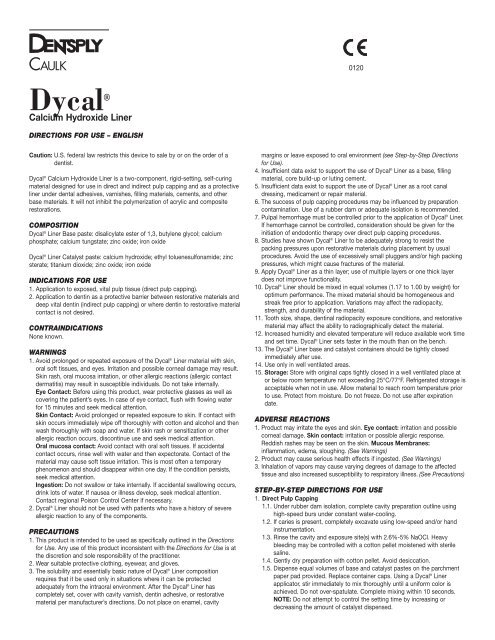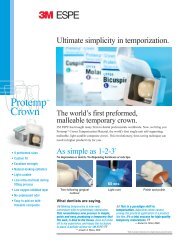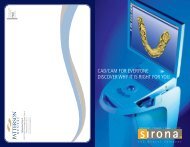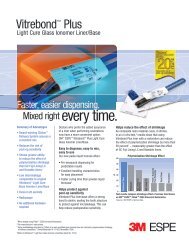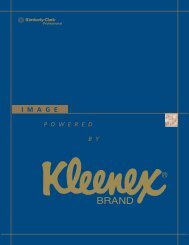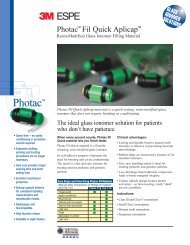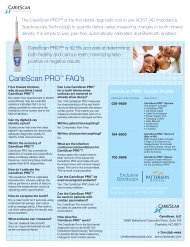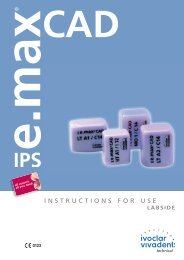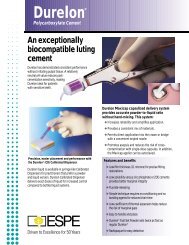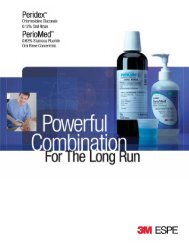Dycal - Caulk
Dycal - Caulk
Dycal - Caulk
You also want an ePaper? Increase the reach of your titles
YUMPU automatically turns print PDFs into web optimized ePapers that Google loves.
0120<br />
<strong>Dycal</strong> ®<br />
Calcium Hydroxide Liner<br />
DIRECTIONS FOR USE – ENGLISH<br />
Caution: U.S. federal law restricts this device to sale by or on the order of a<br />
dentist.<br />
<strong>Dycal</strong> ® Calcium Hydroxide Liner is a two-component, rigid-setting, self-curing<br />
material designed for use in direct and indirect pulp capping and as a protective<br />
liner under dental adhesives, varnishes, filling materials, cements, and other<br />
base materials. It will not inhibit the polymerization of acrylic and composite<br />
restorations.<br />
COMPOSITION<br />
<strong>Dycal</strong> ® Liner Base paste: disalicylate ester of 1,3, butylene glycol; calcium<br />
phosphate; calcium tungstate; zinc oxide; iron oxide<br />
<strong>Dycal</strong> ® Liner Catalyst paste: calcium hydroxide; ethyl toluenesulfonamide; zinc<br />
sterate; titanium dioxide; zinc oxide; iron oxide<br />
INDICATIONS FOR USE<br />
1. Application to exposed, vital pulp tissue (direct pulp capping).<br />
2. Application to dentin as a protective barrier between restorative materials and<br />
deep vital dentin (indirect pulp capping) or where dentin to restorative material<br />
contact is not desired.<br />
CONTRAINDICATIONS<br />
None known.<br />
WARNINGS<br />
1. Avoid prolonged or repeated exposure of the <strong>Dycal</strong> ® Liner material with skin,<br />
oral soft tissues, and eyes. Irritation and possible corneal damage may result.<br />
Skin rash, oral mucosa irritation, or other allergic reactions (allergic contact<br />
dermatitis) may result in susceptible individuals. Do not take internally.<br />
Eye Contact: Before using this product, wear protective glasses as well as<br />
covering the patient’s eyes. In case of eye contact, flush with flowing water<br />
for 15 minutes and seek medical attention.<br />
Skin Contact: Avoid prolonged or repeated exposure to skin. If contact with<br />
skin occurs immediately wipe off thoroughly with cotton and alcohol and then<br />
wash thoroughly with soap and water. If skin rash or sensitization or other<br />
allergic reaction occurs, discontinue use and seek medical attention.<br />
Oral mucosa contact: Avoid contact with oral soft tissues. If accidental<br />
contact occurs, rinse well with water and then expectorate. Contact of the<br />
material may cause soft tissue irritation. This is most often a temporary<br />
phenomenon and should disappear within one day. If the condition persists,<br />
seek medical attention.<br />
Ingestion: Do not swallow or take internally. If accidental swallowing occurs,<br />
drink lots of water. If nausea or illness develop, seek medical attention.<br />
Contact regional Poison Control Center if necessary.<br />
2. <strong>Dycal</strong> ® Liner should not be used with patients who have a history of severe<br />
allergic reaction to any of the components.<br />
PRECAUTIONS<br />
1. This product is intended to be used as specifically outlined in the Directions<br />
for Use. Any use of this product inconsistent with the Directions for Use is at<br />
the discretion and sole responsibility of the practitioner.<br />
2. Wear suitable protective clothing, eyewear, and gloves.<br />
3. The solubility and essentially basic nature of <strong>Dycal</strong> ® Liner composition<br />
requires that it be used only in situations where it can be protected<br />
adequately from the intraoral environment. After the <strong>Dycal</strong> ® Liner has<br />
completely set, cover with cavity varnish, dentin adhesive, or restorative<br />
material per manufacturer’s directions. Do not place on enamel, cavity<br />
margins or leave exposed to oral environment (see Step-by-Step Directions<br />
for Use).<br />
4. Insufficient data exist to support the use of <strong>Dycal</strong> ® Liner as a base, filling<br />
material, core build-up or luting cement.<br />
5. Insufficient data exist to support the use of <strong>Dycal</strong> ® Liner as a root canal<br />
dressing, medicament or repair material.<br />
6. The success of pulp capping procedures may be influenced by preparation<br />
contamination. Use of a rubber dam or adequate isolation is recommended.<br />
7. Pulpal hemorrhage must be controlled prior to the application of <strong>Dycal</strong> ® Liner.<br />
If hemorrhage cannot be controlled, consideration should be given for the<br />
initiation of endodontic therapy over direct pulp capping procedures.<br />
8. Studies have shown <strong>Dycal</strong> ® Liner to be adequately strong to resist the<br />
packing pressures upon restorative materials during placement by usual<br />
procedures. Avoid the use of excessively small pluggers and/or high packing<br />
pressures, which might cause fractures of the material.<br />
9. Apply <strong>Dycal</strong> ® Liner as a thin layer; use of multiple layers or one thick layer<br />
does not improve functionality.<br />
10. <strong>Dycal</strong> ® Liner should be mixed in equal volumes (1.17 to 1.00 by weight) for<br />
optimum performance. The mixed material should be homogeneous and<br />
streak free prior to application. Variations may affect the radiopacity,<br />
strength, and durability of the material.<br />
11. Tooth size, shape, dentinal radiopacity exposure conditions, and restorative<br />
material may affect the ability to radiographically detect the material.<br />
12. Increased humidity and elevated temperature will reduce available work time<br />
and set time. <strong>Dycal</strong> ® Liner sets faster in the mouth than on the bench.<br />
13. The <strong>Dycal</strong> ® Liner base and catalyst containers should be tightly closed<br />
immediately after use.<br />
14. Use only in well ventilated areas.<br />
15. Storage: Store with original caps tightly closed in a well ventilated place at<br />
or below room temperature not exceeding 25°C/77°F. Refrigerated storage is<br />
acceptable when not in use. Allow material to reach room temperature prior<br />
to use. Protect from moisture. Do not freeze. Do not use after expiration<br />
date.<br />
ADVERSE REACTIONS<br />
1. Product may irritate the eyes and skin. Eye contact: irritation and possible<br />
corneal damage. Skin contact: irritation or possible allergic response.<br />
Reddish rashes may be seen on the skin. Mucous Membranes:<br />
inflammation, edema, sloughing. (See Warnings)<br />
2. Product may cause serious health effects if ingested. (See Warnings)<br />
3. Inhalation of vapors may cause varying degrees of damage to the affected<br />
tissue and also increased susceptibility to respiratory illness. (See Precautions)<br />
STEP-BY-STEP DIRECTIONS FOR USE<br />
1. Direct Pulp Capping<br />
1.1. Under rubber dam isolation, complete cavity preparation outline using<br />
high-speed burs under constant water-cooling.<br />
1.2. If caries is present, completely excavate using low-speed and/or hand<br />
instrumentation.<br />
1.3. Rinse the cavity and exposure site(s) with 2.6%-5% NaOCl. Heavy<br />
bleeding may be controlled with a cotton pellet moistened with sterile<br />
saline.<br />
1.4. Gently dry preparation with cotton pellet. Avoid desiccation.<br />
1.5. Dispense equal volumes of base and catalyst pastes on the parchment<br />
paper pad provided. Replace container caps. Using a <strong>Dycal</strong> ® Liner<br />
applicator, stir immediately to mix thoroughly until a uniform color is<br />
achieved. Do not over-spatulate. Complete mixing within 10 seconds.<br />
NOTE: Do not attempt to control the setting time by increasing or<br />
decreasing the amount of catalyst dispensed.
1.6. Using the ball-pointed <strong>Dycal</strong> ® Liner applicator or similar instrument, place<br />
the mix directly on the exposed pulp and cavity dentin judged to be less<br />
than 1.0mm remaining thickness in a thin layer. Avoid placing <strong>Dycal</strong> ®<br />
Liner on enamel or the margins of the cavity. Avoid placing a large bulk of<br />
material. Material thickness should be approximately 0.8mm-1mm.<br />
1.7. Allow the <strong>Dycal</strong> ® Liner to completely set. The mixed material will set in<br />
approximately 2-3 minutes on the mixing pad under normal room<br />
conditions (70°F with 50% relative humidity). Set time is shorter in the<br />
mouth due to moisture and temperature.<br />
1.8. Remove any set excess from retention areas, enamel, and/or margins<br />
with a sharp spoon excavator or a bur.<br />
1.9. Place desired adhesive, base, and/or restoration following manufacturer’s<br />
directions.<br />
1.10. At the next appointment, assess the pulp vitality. Pulp vitality and status<br />
should be assessed radiographically every three to six months or as<br />
needed.<br />
2. Indirect Pulp Capping, Protective Barrier<br />
2.1. Under suitable isolation, complete cavity preparation and caries removal.<br />
Wash cavity thoroughly with water spray and air dry.<br />
2.2. Dispense and mix <strong>Dycal</strong> ® Liner components as outlined above in section<br />
1.5.<br />
2.3. Apply mixed material to desired dentin surfaces as outlined above in<br />
sections 1.6-1.8. Quick application of the mixed material into the cavity<br />
takes advantage of the essential flowability of the mass for efficient<br />
placement before setting starts. Completely covering all cavity dentin as<br />
desired may require carrying additional material from pad to dentin<br />
surfaces. NOTE: If subsequent use of a dentin bonding agent is desired,<br />
place <strong>Dycal</strong> ® Liner only on the deepest (less than 1mm remaining) dentin,<br />
leaving the rest of the cavity surface free for bonding.<br />
2.4. Following completion of set (see section 1.7) remove any set excess from<br />
retention areas, enamel, and/or margins with a sharp spoon excavator or<br />
a bur.<br />
2.5. Complete restoration per restorative material manufacturer’s directions<br />
for use.<br />
CLEANING AND DISINFECTION INSTRUCTIONS<br />
Tubes and caps may be cleaned by scrubbing with hot water and soap or<br />
detergent. Tubes should be wiped, not immersed. Tubes exposed to spatter or<br />
spray of body fluids, or touched by contaminated hands or oral tissues, should<br />
be disinfected with a hospital-level disinfectant. Acceptable disinfectants are<br />
EPA registered as tuberculocidal. Iodophors, sodium hypochlorite (5.25%),<br />
chlorine dioxide and dual or synergized quaternaries are approved disinfectants.<br />
Do not immerse tubes in disinfectant. Disinfect the tubes by spraying or wiping<br />
with any recommended hospital-level surface disinfectant for the contact time<br />
recommended by the disinfectant manufacturer for optimum results. Spraying<br />
with glutaraldehyde is not recommended. Some phenolic-based agents and<br />
iodophor-based products may cause surface staining. Agents containing organic<br />
solvents such as alcohol may tend to degrade the tubes and caps. The<br />
disinfectant manufacturer’s directions should be followed properly for optimum<br />
results. Water-based disinfectant solutions are preferred.<br />
LOT NUMBER AND EXPIRATION DATE<br />
1. Do not use after expiration date. ISO standard uses: “YYYY/MM.”<br />
2. The following numbers should be quoted in all correspondences:<br />
• Reorder number<br />
• Lot number on package<br />
• Expiration date<br />
Manufactured in the U.S.A. by:<br />
DENTSPLY <strong>Caulk</strong><br />
38 West Clarke Ave.<br />
Milford, DE 19963<br />
Tel.: 1-302-422-4511<br />
Distributed by:<br />
DENTSPLY Canada<br />
161 Vinyl Court<br />
Woodbridge, Ontario<br />
L4L 4A3 Canada<br />
Authorized EU Representative:<br />
DENTSPLY DeTrey GmbH<br />
De-Trey-Str. 1<br />
78467 Konstanz<br />
Germany<br />
Tel.: (49) (07531) 583-0<br />
Swiss Representative:<br />
DENTSPLY DeTrey<br />
Baar Office<br />
Oberdorfstrasse 11<br />
6342 Baar<br />
Switzerland<br />
Tel.: (41) (041) 7662066<br />
Printed in U.S.A.<br />
Form #523001 (R 1/28/05)<br />
©2005 DENTSPLY International Inc. All Rights Reserved.


